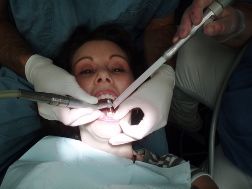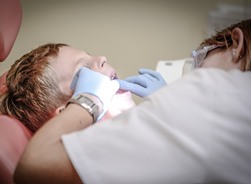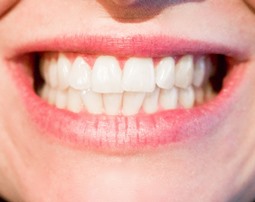How to Select a Dental Hygienist College near Riverside Washington
 Choosing the right dental hygienist school near Riverside WA is an essential first step toward starting your new career in dentistry. But before you can make your selection, you must analyze and compare your school options. There is much more to performing your due diligence than choosing the school with the most affordable tuition or enrolling in the school that is nearest to your residence. There are other important factors to consider also, including the college’s reputation and accreditation. Dental hygienists typically earn an Associate Degree, as compared to a certificate usually earned by assistants, and can take anywhere from two to three years to accomplish. Naturally with the more extensive training of a hygienist comes more expense. We will explore all of these concerns and additional questions that you need to be asking the dental hygienist programs you are evaluating later in this article. But first, let’s explore the duties of dental hygienists and the training programs offered.
Choosing the right dental hygienist school near Riverside WA is an essential first step toward starting your new career in dentistry. But before you can make your selection, you must analyze and compare your school options. There is much more to performing your due diligence than choosing the school with the most affordable tuition or enrolling in the school that is nearest to your residence. There are other important factors to consider also, including the college’s reputation and accreditation. Dental hygienists typically earn an Associate Degree, as compared to a certificate usually earned by assistants, and can take anywhere from two to three years to accomplish. Naturally with the more extensive training of a hygienist comes more expense. We will explore all of these concerns and additional questions that you need to be asking the dental hygienist programs you are evaluating later in this article. But first, let’s explore the duties of dental hygienists and the training programs offered.
[campusexplorer header_text=”Find Dental Hygienist Schools Near You!” aos=”75346615″ concentration=”2D77CE61″ tracking=”DENTHYG”]
The Function of a Dental Hygienist
 When comparing the duties of a dental hygienist to that of an assistant, the most significant difference is probably that the hygienist works more independently. Dental assistants work with and in support of the Riverside WA dentists and the practice. Hygienists, while also supporting the practice, work with the patients more on a one-to-one basis. They are frequently the first person a patient interacts with when called from the waiting room. They examine every patient’s teeth and gums and present their findings to the dentists. They may also carry out basic procedures. Depending on state law, a hygienist’s responsibilities can include:
When comparing the duties of a dental hygienist to that of an assistant, the most significant difference is probably that the hygienist works more independently. Dental assistants work with and in support of the Riverside WA dentists and the practice. Hygienists, while also supporting the practice, work with the patients more on a one-to-one basis. They are frequently the first person a patient interacts with when called from the waiting room. They examine every patient’s teeth and gums and present their findings to the dentists. They may also carry out basic procedures. Depending on state law, a hygienist’s responsibilities can include:
- Removing tartar, stains and plaque
- Applying fluoride treatments
- Polishing teeth and applying sealants
- Instructing patients regarding oral hygiene
- Taking X-rays and developing film
- Removing sutures and applying fillings
In order to be licensed in almost all states, dental hygienists must have graduated from a Commission on Dental Accreditation (CDA) accredited dental hygiene program. They must also pass the National Board Dental Hygiene Examination in addition to passing any state licensing exams. When they have fulfilled these requirements they are deemed fully licensed and can add the “RDH” designation to their names, standing for Registered Dental Hygienist.
Dental Hygienist Education Options
Due to the additional responsibility as compared to an assistant, dental hygienists working in Riverside WA dental practices are normally required to have an Associate Degree in dental hygiene rather than a certificate. These programs can require anywhere from two to as long as three years to finish and must be accredited by the CDA in virtually every state. They are offered in trade and vocational schools as well as community colleges. And in addition to classroom studies learning the fundamentals of dental hygiene, there will be a clinical component to the training as well| A number of programs also offer internships with local dental practices or dentists.
Online Dental Hygienist Training Programs
 Enrolling in an online dental hygienist school may be a viable option for receiving your education. Just keep in mind that the program will not be totally online, since there will be a practical component to your training. But the balance of your classes will be accessible by means of your desktop computer in the comfort of your Riverside WA home or elsewhere on your laptop or tablet. For those continuing to work while going to school, online dental programs make education a lot more accessible. Many may even charge lower tuition fees than their on-campus competitors. And additional expenses for items like commuting, books and school supplies may be reduced as well. The practical training can typically be completed at an area dental office or in an on-campus lab. With both the clinical and online training, everything needed to obtain the appropriate education is furnished. If you have the dedication for this method of learning, you may find that enrolling in an online dental hygienist college is the best option for you.
Enrolling in an online dental hygienist school may be a viable option for receiving your education. Just keep in mind that the program will not be totally online, since there will be a practical component to your training. But the balance of your classes will be accessible by means of your desktop computer in the comfort of your Riverside WA home or elsewhere on your laptop or tablet. For those continuing to work while going to school, online dental programs make education a lot more accessible. Many may even charge lower tuition fees than their on-campus competitors. And additional expenses for items like commuting, books and school supplies may be reduced as well. The practical training can typically be completed at an area dental office or in an on-campus lab. With both the clinical and online training, everything needed to obtain the appropriate education is furnished. If you have the dedication for this method of learning, you may find that enrolling in an online dental hygienist college is the best option for you.
What to Cover With Dental Hygienist Colleges
 Now that you have decided to become a dental hygienist in Riverside WA, you can begin the procedure of comparing schools and programs. As we covered at the opening of this article, a number of potential students start by checking out the location and the cost of the colleges. Maybe they look for several online options also. Although these are significant initial factors to consider, there are a few additional questions that you need to ask of the programs you are reviewing in order to make an informed decision. Toward that end, we have included a list of questions to assist you with your due diligence and ultimate selection of the ideal dental hygienist program for you.
Now that you have decided to become a dental hygienist in Riverside WA, you can begin the procedure of comparing schools and programs. As we covered at the opening of this article, a number of potential students start by checking out the location and the cost of the colleges. Maybe they look for several online options also. Although these are significant initial factors to consider, there are a few additional questions that you need to ask of the programs you are reviewing in order to make an informed decision. Toward that end, we have included a list of questions to assist you with your due diligence and ultimate selection of the ideal dental hygienist program for you.
Is the Dental School Accredited? There are many valid reasons why you should only choose an accredited dental hygienist college. If you are intending to become certified or licensed, then accreditation is a requirement in nearly all states. In order to take the National Board Dental Hygiene Examination, your dental college must be accredited by the Commission on Dental Accreditation (CDA). Accreditation also helps guarantee that the training you receive is comprehensive and of the highest quality. Riverside WA employers often desire or require that new hires are graduates of accredited colleges. And last, if you are applying for a student loan or financial aid, usually they are not available for non-accredited colleges.
Is Adequate Clinical Training Provided? Practical or clinical training is an essential portion of every dental training program. This holds true for the online school options also. A number of dental hygienist programs have relationships with area dental practices and clinics that furnish clinical training for their students. It’s not only essential that the program you enroll in offers adequate clinical hours but also provides them in the kind of practice that you subsequently want to work in. As an example, if you have an interest in a career in pediatric dentistry, check that the school you enroll in offers clinical rotation in a local Riverside WA dental practice that focuses on dental care for children.
Is There an Internship Program? Ask if the dental colleges you are looking at sponsor internship programs. Internships are probably the ideal means to get hands-on, clinical experience in a professional dental practice. They help students to transition from the theoretical to the practical. They can also help students develop professional relationships in the Riverside WA dentistry community. And they are attractive on resumes too.
Is Job Placement Support Furnished? Most graduating students of dental hygienist colleges require help landing their first job. Find out if the colleges you are considering have job assistance programs, and what their job placement rates are. Schools with high job placement rates probably have excellent reputations within the Riverside WA dental community in addition to extensive networks of contacts where they can refer their students for employment or internships.
Are the Classrooms Smaller? Ask the programs you are looking at how big on average their classrooms are. The smaller classes usually offer a more personal setting for training where students have greater access to the instructors. On the other hand, larger classes often are impersonal and offer little one-on-one instruction. If practical, find out if you can monitor a couple of classes at the Riverside WA dental hygienist school that you are most interested in in order to witness first hand the amount of interaction between teachers and students before making a commitment.
What is the Total Cost of the Program? Dental hygiene programs can differ in cost depending on the length of the program and the volume of clinical training provided. Other factors, for instance the reputations of the colleges and if they are public or private also come into play. But besides the tuition there are other significant costs which can add up. They can include expenses for such things as textbooks and commuting as well as school equipment, materials and supplies. So when examining the cost of programs, remember to add all of the costs associated with your education. Most colleges have financial aid departments, so be sure to ask what is available as far as grants, loans and scholarships in the Riverside WA area.
Are the Classes Accessible? Before selecting a dental hygienist college, you must make sure that the assistant or hygienist program provides classes that fit your schedule. This is especially true if you continue working while receiving your education and need to go to classes near Riverside WA at nights or on weekends. And even if you enroll in an online college, you will still need to schedule your practical training classes. Also, while making your inquiries, ask what the make-up policy is if you should need to miss any classes because of illness, work or family issues.
Attending Dental Hygienist School near Riverside WA?
Riverside, Washington
Riverside was first settled in the 1880s by Uriah Ward. When steamboats began traveling up the Okanogan River, Riverside was the upstream limit of navigation during the high water season.[6] Riverside was officially incorporated on December 22, 1913.
Riverside is located at 48°30′10″N 119°30′31″W / 48.50278°N 119.50861°W / 48.50278; -119.50861 (48.502830, -119.508718).[7] According to the United States Census Bureau, the town has a total area of 0.99 square miles (2.56 km2), of which, 0.97 square miles (2.51 km2) is land and 0.02 square miles (0.05 km2) is water.[1] Sometimes considered to be part of Greater Omak, it is home to the Omak Airport.
As of the census[2] of 2010, there were 280 people, 128 households, and 78 families residing in the town. The population density was 288.7 inhabitants per square mile (111.5/km2). There were 154 housing units at an average density of 158.8 per square mile (61.3/km2). The racial makeup of the town was 87.1% White, 7.5% Native American, 1.8% from other races, and 3.6% from two or more races. Hispanic or Latino of any race were 6.4% of the population.
There were 128 households of which 23.4% had children under the age of 18 living with them, 45.3% were married couples living together, 10.9% had a female householder with no husband present, 4.7% had a male householder with no wife present, and 39.1% were non-families. 32.8% of all households were made up of individuals and 10.9% had someone living alone who was 65 years of age or older. The average household size was 2.17 and the average family size was 2.68.
Find the Ideal Dental Hygienist School near Riverside WA
Choosing the right dental hygienist course is imperative if you want to take the National Board Dental Hygiene examination or, if required in your state, become licensed. As we have covered, there are many alternatives offered to receive your training and it takes a fairly short amount of time to become a dental hygienist. You can acquire your formal education through dental programs at junior colleges, technical institutes, trade schools and vocational schools. Graduates of these schools normally earn an Associate Degree. Dental Hygienists normally require roughly 2 years of studies before they enter the work force. When pursuing a degree you can choose to go to classes online or on-campus. Whichever mode of training you decide to pursue, by asking the questions provided in this article you will be in a better position to make the right choice. And as a result, you will be ready to start your journey toward becoming a dental hygienist in Riverside WA.
More Great Cities in Washington
Business Results 1 - 10 of 1

